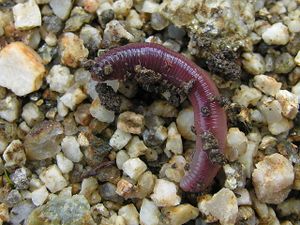سرجيات
| سرجيات | |
|---|---|

| |
| Earthworm | |
| التصنيف العلمي | |
| أصنوفة غير معروفة (أصلحها): | سرجيات |
| Subclasses | |
|
Branchiobdellae | |
السرجيات (الاسم العلمي: Clitellata) هي class of annelid worms, characterized by having a clitellum - the 'collar' that forms a reproductive cocoon during part of their life cycles. The clitellates comprise around 8,000 species. Unlike the class of Polychaeta, they do not have parapodia and their heads are less developed.
التكاثر
All clitellata are hermaphrodites. During reproduction, the clitellum secretes a coat which hardens. The worm then creeps out backward from the coat and deposits either fertilized zygotes or both ovae and sperm into the coat, which is then packed into a cocoon. The zygotes then develop directly in the cocoon without passing through a larval stage (as opposed to other annelids, e.g. Polychaeta.) This mechanism is considered to be apomorphic (a newly derived characteristic rather than an evolutionarily ancestral one).[2]
التنظيم
According to modern phylogenetic analyses, the Clitellata are considered to be a monophyletic subclade of the polychaetes.
رتب
انظر أيضاً
مراجع
- ^ Manum, S. B.; Bose, M. N.; Sawyer, R. Y. T. (1991). "Clitellate cocoons in freshwater deposits since the Triassic". Zoologica Scripta. 20 (4): 347. doi:10.1111/j.1463-6409.1991.tb00300.x.
- ^ Reichardt (2006): pp.63, 67-68
المراجع
- Erséus, Christer; Wetzel, Mark J. & Gustavsson, Lena (2008): ICZN rules – a farewell to Tubificidae (Annelida, Clitellata). Zootaxa 1744: 66–68. PDF fulltext
- Reichardt, Anna Katharina (2006): Systematische Zoologie.